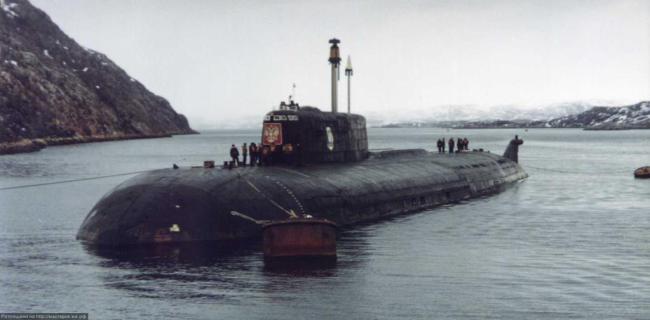

Her weapons included 18 SS-N-16 "Stallion" anti-submarine missiles. The torpedo tubes could be used to launch either torpedoes or anti-ship missiles with a range of 50 km (31 mi). They were designed to swarm enemy vessels and intelligently choose individual targets which terminated with a dive onto the target. The Granit missiles with a range of 550 km (340 mi), were capable of supersonic flight at altitudes over 20 km (12 mi).

The submarine was armed with 24 SS-N-19/P-700 Granit cruise missiles, and eight torpedo tubes in the bow: four 533 mm (21 in) and four 650 mm (26 in). The sail superstructure was reinforced to allow it to break through the Arctic ice. She was designed to remain submerged for up to 120 days. There was a 200 mm (7.9 in) gap to the 50.8 mm (2.00 in)-thick steel pressure hull. The outer hull, made of high- nickel, high- chromium stainless steel 8.5 mm (0.33 in) thick, had exceptionally good resistance to corrosion and a weak magnetic signature which helped prevent detection by U.S. The senior officers had individual staterooms and the entire crew had access to a gymnasium. She was 9.1 m (30 ft) longer than the preceding Oscar I-class of submarines. Both missiles and torpedoes could be equipped with nuclear warheads. A single Type 65 torpedo carried a 450 kg (990 lb) warhead powerful enough to sink an aircraft carrier. : 22–23 It was built to defeat an entire United States aircraft carrier group. They are the second-largest cruise missile submarines ever built, after some Ohio-class submarine ballistic missile submarines were converted to carry cruise missiles in 2007. The Antey design represented the highest achievement of Soviet nuclear submarine technology. Kursk was assigned to the home port of Vidyayevo, Murmansk Oblast. K-141 was inherited by Russia and launched in 1994, before being commissioned by the Russian Navy on December 30, as part of the Russian Northern Fleet. In 1993 K-141 was named Kursk after the Battle of Kursk in the 50-year anniversary of this battle. During the construction of K-141, the Soviet Union collapsed work continued, and she became one of the first naval vessels completed after the collapse. Construction began in 1990 at the Soviet Navy military shipyards in Severodvinsk, near Arkhangelsk, in the northern Russian SFSR. K-141 Kursk was a Project 949A class Antey ( Russian: Aнтей, meaning Antaeus) submarine of the Oscar class, known as the Oscar II by its NATO reporting name, and was the penultimate submarine of the Oscar II class designed and approved in the Soviet Union. On 12 August 2000, K-141 Kursk was lost when it sank in the Barents Sea, killing all 118 personnel on board.Ĭonstruction Silhouette of an Oscar-II class submarine Atomnaya Podvodnaya Lodka "Kursk" (APL "Kursk"), meaning "Atomic-powered submarine Kursk") was an Oscar II-class nuclear-powered cruise missile submarine of the Russian Navy.

Raised from the seafloor (except bow), towed to shipyard, and dismantledġ3,400 to 16,400 tonnes (13,200 to 16,100 long tons 14,800 to 18,100 short tons) Ģ OK-650b nuclear reactors ( HEU <= 45% ), 2 steam turbines, two 7-bladed propellersģ2 knots (59 km/h 37 mph) submerged, 16 knots (30 km/h 18 mph) surfacedģ00 to 500 m (980 to 1,640 ft) by various estimatesĢ4 × SS-N-19/P-700 Granit, 4 × 533 mm (21 in) and 2 × 650 mm (26 in) torpedo tubes (bow) 24 torpedoes For the Kansas state highway, see K-141 (Kansas highway).Īll 118 hands lost in 100 m (330 ft) of water in Barents Sea on 12 August 2000


 0 kommentar(er)
0 kommentar(er)
